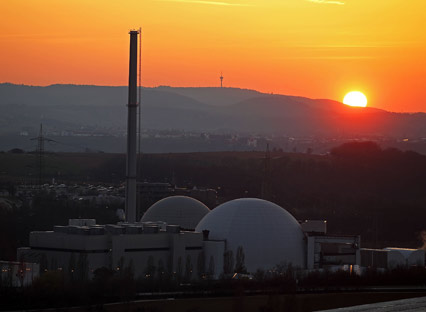Is uranium set to be the next big commodities story?
Price is languishing well below its peak, but demand for nuclear is growing

After the horrors of Three Mile Island, Chernobyl and more recently Fukishima, the nuclear sector finally seems to be within touching distance of a glorious renaissance.
Its comeback has been aided by increasing concerns about climate change. Even dedicated greens such as Mark Lynas and George Monbiot admit that nuclear has a vital role to play in a post-fossil fuel, low-carbon energy mix.
Momentum seemed to be building fastest in the emerging markets, with China very much taking the lead.
The Week
Escape your echo chamber. Get the facts behind the news, plus analysis from multiple perspectives.

Sign up for The Week's Free Newsletters
From our morning news briefing to a weekly Good News Newsletter, get the best of The Week delivered directly to your inbox.
From our morning news briefing to a weekly Good News Newsletter, get the best of The Week delivered directly to your inbox.
As of January 2017, China still had 22 nuclear power reactors under construction, 40 planned for construction, and 136 under proposal, all alongside the 35 already in operation, according to the World Nuclear Association.
China is currently spending $570bn (£454bn) targeting ten per cent of its electricity generation from nuclear, with plans to double capacity by 2020.
Even the UK government has green-lighted a hugely ambitious nuclear project that will see a whole fleet of new plants built that could ultimately provide 35 per cent of UK electricity needs.
But this giddy enthusiasm hasn't quite percolated through into the hard-nosed world of international finance - and especially not the commodity markets.
A free daily email with the biggest news stories of the day – and the best features from TheWeek.com
Uranium languishing
The spot price of uranium, the mined material that fuels nuclear reactions, is currently around $25 per pound - 60 per cent below its level ten years ago and 85 per cent below its high in mid-2007 of around $140 per pound.
The bears' case against uranium has been helped by the knock-on effects of the Fukushima disaster in 2011 and Germany’s subsequent decision to retire its nuclear fleet.
Amongst policymakers and energy planners, support for nuclear power in the developed world makers has been undermined by a wide range of factors, not least rapidly declining oil and gas prices and massive investment in renewable wind and energy technology.
Set to rise
Yet despite these headwinds, a series of short to medium-term catalysts might help push uranium prices higher.
In addition to the big investment going on in China and India, and now in the UK, Japan has for instance decided - not without controversy - that it needs to restart its nuclear fleet. Seven plants will come back online by end-March 2017, and 19 more by March 2018.
Also back in mid-December the spot price for Uranium jumped ten per cent after one major supplier announced that several utilities had entered the market.
Earlier on this year another key catalyst came with the announcement in January that Kazakhstan would be cutting 2017 production by an estimated ten per cent. Given that the nation accounts for just under half global production, this could help boost prices for the nuclear fuel.
The good news for European uranium miners such as Berkeley Energia in Spain, which is currently building the only new uranium mine in the world and the largest ever in Europe, is that supply from these secondary sources has been declining regularly over the last ten years, from 37 per cent to 22 per cent of supply.
Security of supply
Perhaps the most crucial tailwind comes from the peculiar dynamics of this commodity market, which sees most uranium bought by utilities on long term contracts. In short: security of supply is crucial.
Most industry observers now expect demand to grow significantly as US and EU utilities start re-contracting for medium to long term supply. All the new Chinese demand kicking in might also help.
That increased demand will particularly benefit the handful of suppliers in Canada and Kazakhstan – and now in Spain with Berkeley Energia – capable of supplying at the current low prices.
But as secondary sources of supply dry up, new mines will need to come on line: the International Atomic Energy Agency predicts that mine capacity will grow to between 70,000 and 94,000 tons in ten years.
If enough new mines do not open up, uranium demand will likely surge far ahead of supply - and that could send the price rocketing.
How high will Uranium go?
Overall nuclear power and demand for uranium globally is likely to grow about 25-30 per cent over the next ten years. While this only amounts to 2.5 per cent per year growth, there may not be enough low cost supply to meet this demand.
As emerging markets ramp up demand, especially in China, the market dynamics for uranium could tighten quickly. President Trump has indicated he is a big fan of US produced nuclear power, which might help push up demand.
Many reckon that the price of uranium needs to treble to encourage new mining output. The consensus number seems to be $60-80 per pound, compared to the current $25.
Rob Chang Head of Metals & Mining research at Cantor Fitzgerald in Canada for instance estimates a $40 per pound marginal cost level for most uranium miners, with $80 per pound the long-term equilibrium level.
-
 Pipe bombs: The end of a conspiracy theory?
Pipe bombs: The end of a conspiracy theory?Feature Despite Bongino and Bondi’s attempt at truth-telling, the MAGAverse is still convinced the Deep State is responsible
-
 The robot revolution
The robot revolutionFeature Advances in tech and AI are producing android machine workers. What will that mean for humans?
-
 Health: Will Kennedy dismantle U.S. immunization policy?
Health: Will Kennedy dismantle U.S. immunization policy?Feature ‘America’s vaccine playbook is being rewritten by people who don’t believe in them’